30th December
Skateraw and Barns Ness
Our final Sunday outing of 2018 was inspired by a Twitter report of a
Water Pipit near Skateraw in East Lothian. The weather prediction was
favourable so we drove east, first to Dalkeith Morrisons for breakfast
(another 9.75/10), then to a pile of manure in a field overlooking
Torness Nuclear Power Station. It was there we were expecting to see
the Water Pipit and we were mightily encouraged to find many small birds
picking their way along the high ridges of straw and excrement (that
was probably straight out of the cowsheds of the local farm). The
majority of birds we saw on the manure were Rock Pipits .
Their dark olive green plumage on their backs and wings and generally
duller undersides set them apart from other pipits. There are two main
subspecies of Rock Pipits found in the UK, the ‘UK’ Rock Pipit, Anthus
petrosus petrosus, and the Scandinavian rock pipit, Anthus petrosus
littoralis (Follow this link to learn of the identifying characteristics of Rock (and Water) Pipits). The much lighter Meadow Pipit
was also present. From a distance we mistakenly thought the first Meadow
Pipit that came along was a Water Pipit, only to be disappointed when
it came closer. The Meadow Pipit’s back and wing plumage is mainly dark
ochre, and its underside has a light cream colour with prominent dark
streaks.
As
we waited to see if the Water Pipit would make an appearance, I
recalled that there once was a huge cairn in a field close to Skateraw.
It was cleared in the late 19th century, to reveal a burial cist
containing skeletal remains and a Bronze Age dagger .
It’s exact location may have been on the site of the power station, or
even under the piles of manure. A Pied Wagtail snapped me out of my
thoughts of the ancient and modern, and back onto the job at hand. The
wee waggy posed obligingly, its beauty contrasting wonderfully with the
brown background. I caught sight of a few Whimbrel grazing in the far
side of the field, however they were put up by cars passing along the
old A1 road. After an hour of waiting I decided as a last resort to
relocate the car to the roadside 30m on, facing the far side of the
pile. As soon as we arrived there we spotted the Water Pipit. After watching the other Pipit species we both were struck by the differences in plumage of the Water Pipit .
On its underside it had a much whiter base colour and less dark
streaks, and it had a much browner back and wings. A bonny wee bird.
Having
succeeded in achieving our “target” we moved on to Barns Ness where we
walked a circuit around the lighthouse and along the beach. However,
the tide was very low and the sea a long way off, and so were the
birds! A Chaffinch and Carrion Crow were by the lighthouse but that was
it. We did though come across a large, 1m high, plant close to the
birds. I think it is Tree Mallow but I’m not 100% confident.
As we finished our circuit I pointed out how the Gorse
bushes were loaded with their yellow blooms. Usually by the turn of the
year there would be far fewer flowers. John in turn thought the Scots Pine
trees were pretty well loaded with cones. Disappointed with the dearth
of wildlife we said goodbye to the lighthouse and made for Belhaven.
Our final sighting though was taken by John from the passenger side of
the car as we left on the Barns Ness single track access road. It was
of a Pheasant high on the grassy banks of a ridge at the north end of
the Cement Works.
The
light had been OK at the start of our visit but had deteriorated as
time went on. As we left Barns Ness it was very dull. We stopped at
Belhaven Bay for tea and a special treat - John had baked a treacle and
ginger bun. It was the highlight of the day for me, pushing the Water
Pipit into 2nd place. It was an excellent conclusion to an otherwise
quiet day.
Pictures of the Week:
| Rock Pipit |
Meadow Pipit |
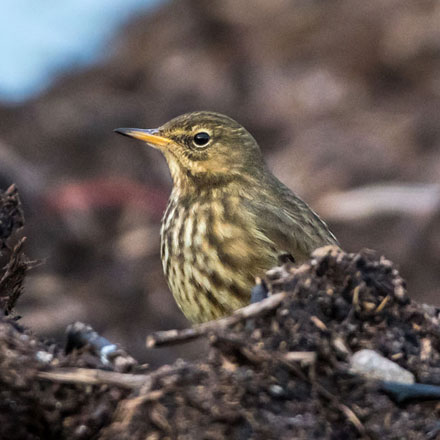 |
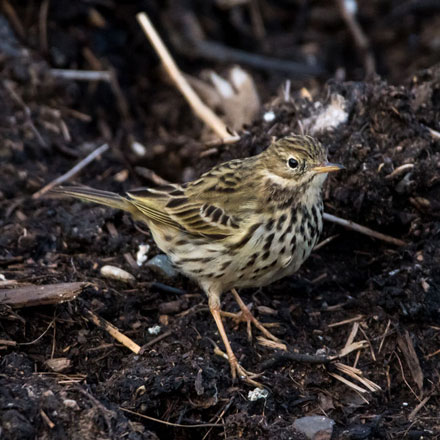 |
| Water Pipit |
Pied Wagtail |
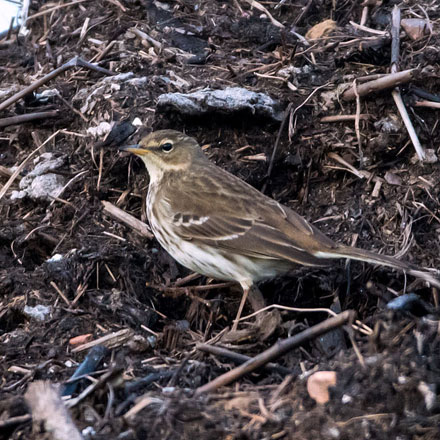 |
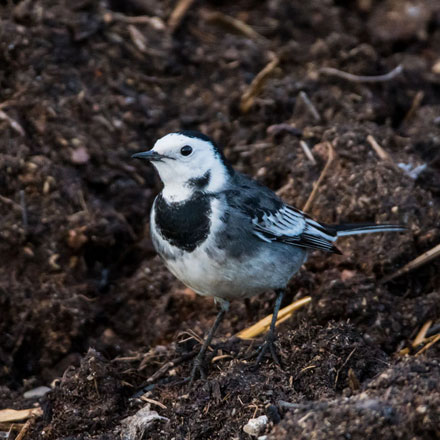 |
23rd December 2018 :
Musselburgh
The
weather map on Sunday morning showed the Forth-Clyde valley was
blanketed in fog which was to clear slowly, with rain possible later in
the west of Scotland. We headed east making for Barns Ness, encouraged
that the fog had lifted in the Edinburgh area, but when we got to
Dalkeith for our usual breakfast (another 9.75/10) we couldn’t see the
usual high landmarks far to the east, such as North Berwick Law, only a
wall of grey mist. A report on Twitter of Red-necked and Black-necked
Grebes at Musselburgh made up our minds - Musselburgh it was. We
started at the River Esk at Millhill car park where we found a large
gathering of birds in the water. There were great photo-opportunities
as Mallards flew in to bread as did a Duclair Duck. A flock of Goldeneye
were busy diving for food in between flirtations with the opposite sex.
The males display before females by throwing their heads back
vigorously onto their rumps (see “Pictures of the Week”, below). As I
photographed the Goldeneyes, four Mute Swans paddled past very close to
the bank.
| Drake Mallard |
Duclair Duck |
Goldeneye |
Mute Swan |
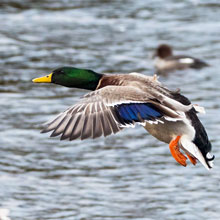 |
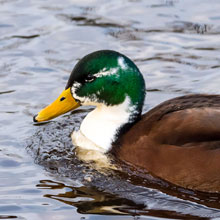 |
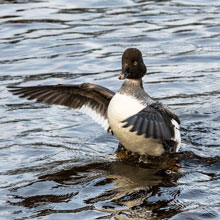 |
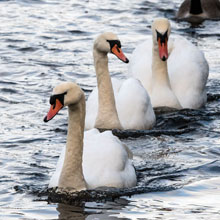 |
The Goldeneyes found a food source below the Swans. According to the RSPB
website, they like mussels, insect larvae and plants. John pointed out
that he could see them swimming under the water and I managed a few
shots of a busy submerged drake. A few Greylag geese flew in honking
noisily as they landed (see also “Pictures of the Week”, below),
watched carefully by a Black-headed Gull and Canada Geese that had been
snoozing contentedly in the shallows.
| Goldeneye |
Greylag Goose |
Black - headed Gull |
Canada Goose |
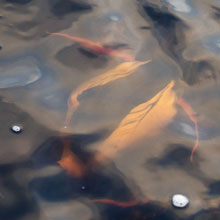 |
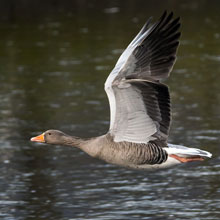 |
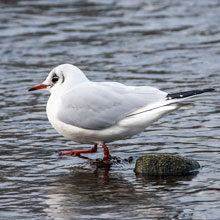 |
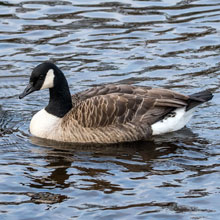 |
We
relocated downstream to the Esk mouth. The tide was high and getting
higher. Although a few patches of blue sky were breaking, it was still
rather overcast so the light wasn’t great. Looking across the Firth of
Forth we could see a blanket of mist stretching from Burntisland west
down the Estuary. Only a hilltop transmitter was visible above the
mist. We walked east, peeking regularly over the sea wall hoping to
spot small waders very close to shore. Some Redshanks, Turnstones and a
solitary Mallard obliged, only to be put up by walkers.
|
Redshank |
Turnstone |
Drake Mallard |
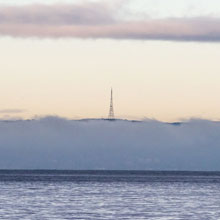 |
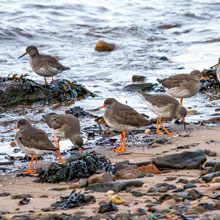 |
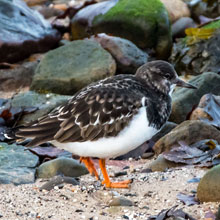 |
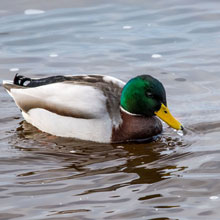 |
The
walk toward the Scrapes yielded some nice sightings. A lonely, sleeping
drake Eider bobbed in the waves. We thought it could have been unwell.
John caught sight of a Great Crested Grebe fishing warily, as did, a bit
further out, a few Velvet Scoter. Then I thought I had snapped a
Slavonian Grebe, but, on inspecting the picture, saw it was a winter
plumage Black-necked Grebe - a newby for us.
| Eider |
Great Crested Grebe |
Velvet Scoter |
Black - necked Grebe |
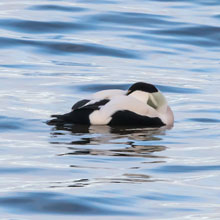 |
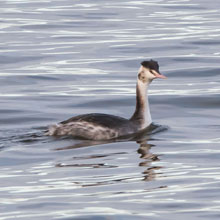 |
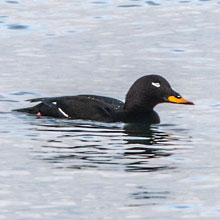 |
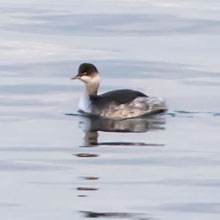 |
As
we continued our amble towards the Scrapes, four Wigeon left their flock
that was about 400m offshore, and flew over the sea wall into the
reserve. I photographed a pair of male Reed Buntings that had landed
on the wall. I noticed that the view across the Forth had brightened.
Perhaps we too were to be treated to some late sunshine. At the path
into the Scrapes a cheeky wee Blue Tit checked me out before tweeting
it’s discontent and flying off.
| Wigeon |
Reed Bunting |
|
Blue Tit |
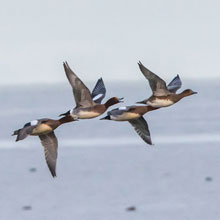 |
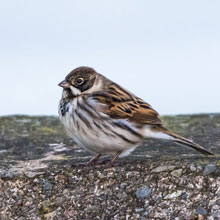 |
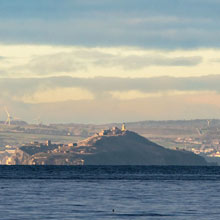 |
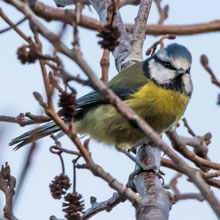 |
From
the middle hide we were pleased to see quite a number of birds settled
on the rear pools. They were mainly Bar-tailed Godwits, Oystercatchers
and Lapwings, each numbering in high double figures.
| Bar - tailed Godwit |
Oystercatcher |
Lapwing |
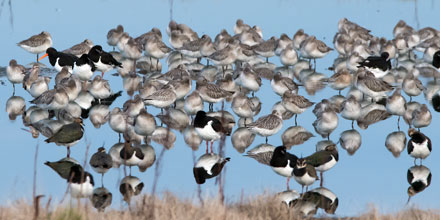 |
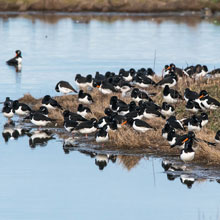 |
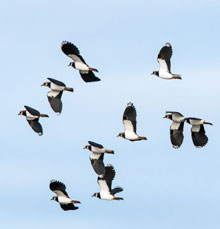 |
We
moved to the “left hide from which I spotted some Widgeon in the grass
- most likely those we’d seen earlier. On the scrape some Redshanks and
Dunlin were foraging in the mud, while on the grassy banks
Oystercatchers were preening, feeding and, most characteristically,
sounding off. I caught a nice shot of a Black-headed Gull, lit up by the
emerging sun.
| Wigeon |
Redshank |
Oystercatcher |
Black - headed Gull |
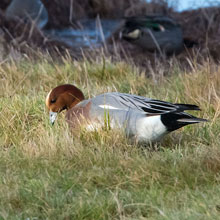 |
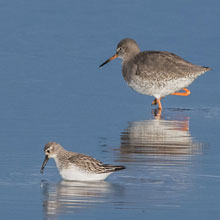 |
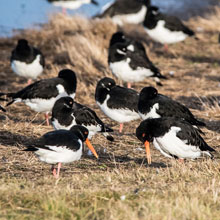 |
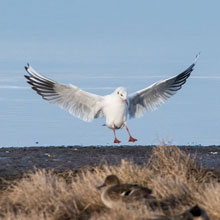 |
In the centre-pool there were Lapwings, ever-watchful for that aerial threat of the hunting raptor.
I
took some images of Teal dabbling on the edges of the pool (see also
“Pictures of the Week”, below) before we decided to make our way back
to the car. On our return journey I managed a shot of a Shag fishing
close-in. We saw the sleeping Eider still in the same place
strengthening our initial suspicions that it was ill. The sun
disappeared once more as reached the car. Perching birds became
silhouettes.
Another
enjoyable outing had reached its end, but not before we had downed some
lattice pastries with mugs of strong tea. Highlight of the day for me
was the Black-necked Grebe sighting as I love a newby, and for once we
actually managed to see one of our “target” birds.
Pictures of the Week:
| Mallard |
Goldeneye |
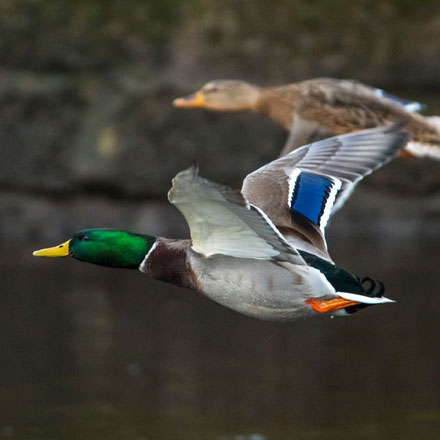 |
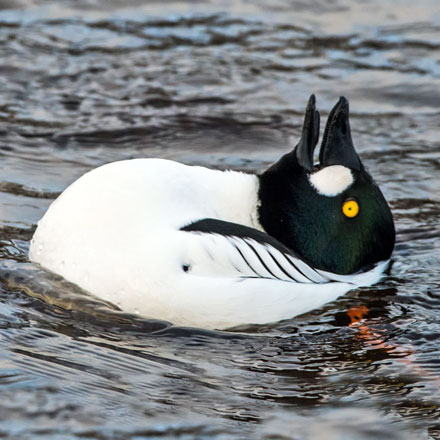 |
| Greylag Goose |
Teal |
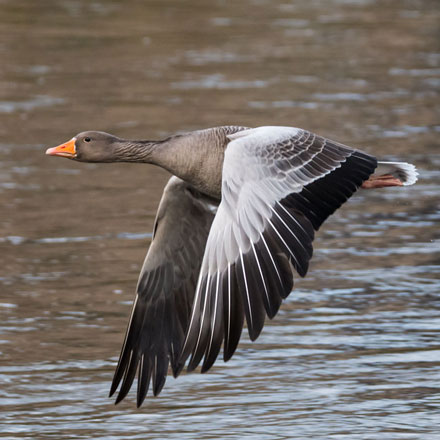 |
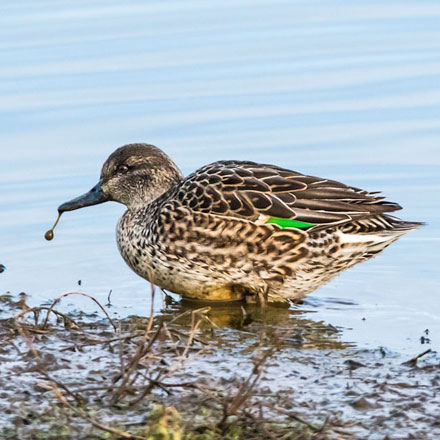 |
16th December 2018:
Tyninghame Bay
It was another very encouraging weather prediction last Saturday night.
Sunday was to be rainfree, with only moderate winds. I chose to visit
Tyninghame Bay, which is part of John Muir Country Park (JMCP), just
west of Dunbar. It is a great place to see waders and sea birds.
Recently Shore Larks were seen in the salt marshes at the edges of the
Bay, so we hoped for better luck that last week at Aberlady. The skies
were indeed cloudless and blue when we entered Dalkeith Morrisons for
breakfast (a superb 9.75/10, but -0.25 for a leaky teapot!), and it was
still fine weather when we reached the JMCP car park. It wasn’t
long until we were making our way along the salt marsh towards the Tyne
Sands and the area where the Shore Larks had been seen. The marsh was
very quiet. Only a few distant Redshanks and a Herring Gull graced us
with their presence. But that changed when we reached the end of the
salt marsh. I spotted a half dozen Redshanks some 50m away and as I
edged closer to them I came across a half dozen or so Skylarks .
I also noticed that there were a few Twites nervously moving about the
grasses (also, see “Pictures of the Week”, below). When
some passing walkers put them up, we were amazed to find that there were
at least a couple of hundred Twite in the flock, which was nice to see
as nationally their numbers have plummeted in recent years. The Twite were active in the area the Shore Larks were seen - but, sadly, we didn’t see them.
| Herring Gull |
Skylark |
Redshank |
Twite |
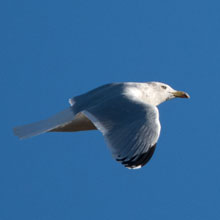 |
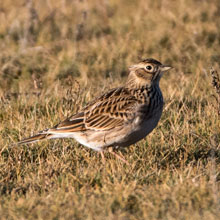 |
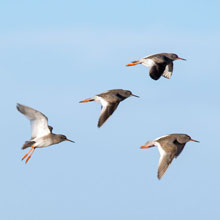 |
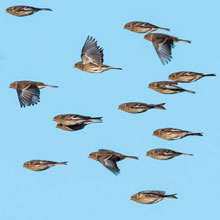 |
The flock drew large figures of eight in the sky as the birds searched for a safe place to land.
I managed some pretty decent shots before they eventually settled near
the sand dunes. Just beyond them I noticed a well-lit Goldfinch sitting
munching seeds on top of a stalk (also, see “Pictures of the
Week”, below). We were able to move across the extensive sands to
the River Tyne as the tide was reaching its low point. An Oystercatcher
was picking at seaweed before taking off as we arrived. We settled on
our 3-legged stools, precariously, as they were slowly sinking into the
soft sand. A female Red-breasted Merganser flew upstream past us, it’s face nicely lit by the low sun.
| Twite |
Goldfinch |
Oystercatcher |
Red - breasted Merganser |
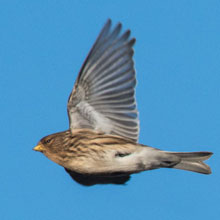 |
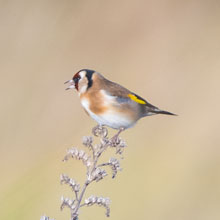 |
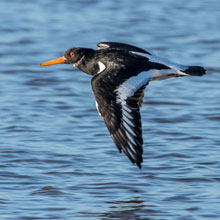 |
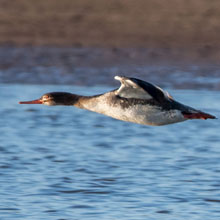 |
There were a few birds across the river, all well illuminated. A
Bar-tailed Godwit trod knee deep probing the riverbed for
invertebrates, as a Common Gull sat motionless, watching. A Curlew that
had originally been on our side of the river, had just landed on the
sands, about 10m from the Gull. A pair of Carrion Crows (also,
see “Pictures of the Week”, below) flew upstream into the
sunlight, one attempting to rob the other of a tasty mollusc.
| Bar - tailed Godwit |
Common Gull |
Curlew |
Carrion Crow |
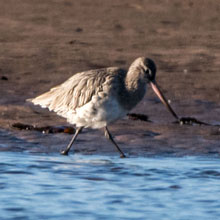 |
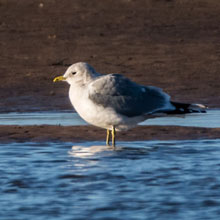 |
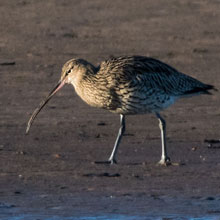 |
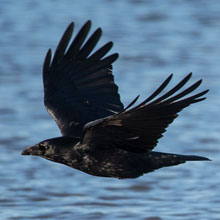 |
We trudged through the deep, damp sands towards the mouth of the river,
trying to catch up with a swim of Shags. They were too fast for us, but
we “cut the corner” across to a point ahead of them and sat
and waited on them rounding the bend. Already on the river mouth was a
handsome drake Eider. Then, after a short delay, the Shags turned up.
There were 9 of them, still diving for fish, unsuccessfully as far as I
could see. Another one joined the group from the air as they moved onto
the opposite rocky shore to dry their wings. Shortly after a solitary Turnstone flew past, and turned out to be the lead bird of a mini invasion.
| Drake Eider |
Shag |
Turnstone |
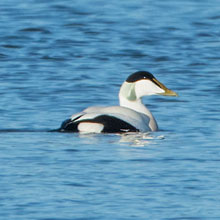 |
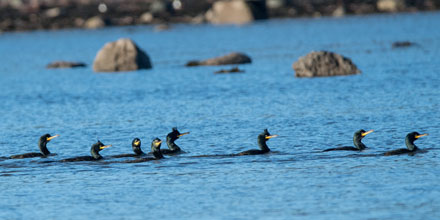 |
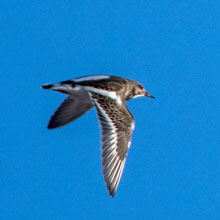 |
We next had an exciting few moments as a sizeable (100+) flock of small
waders flew in, obviously searching for a suitable place to land. As
they were passing we could see that the majority were Dunlin and Sanderling
with a few Turnstones. They circled our position a few times before
eventually going down on an area near where we had photographed the
Curlew. Very satisfied with our sightings at the river we decided to
make our way back to the car via the beautiful beach of Tyninghame Bay.
Apart from a solitary Herring Gull, the shore was devoid of birds.
Perhaps the waders we’d just seen had been put up from there by
dog walkers (of which there were more than a few - and, to be fair,
they had every right to be there). We reasoned that we might see more
if we crossed the sand dunes back onto the salt marsh, so that’s
what we did.
We found the entrance to a suitable path through the stiff dune grasses
but paused briefly to absorb the stunning view of the east side of the
Bay. The picture shows the largely deserted sandy beach. Note the lobster trap
in the foreground. This was one of about a half dozen we saw on the
edges of the river. Maybe the recent stormy weather had displaced them
from their usual positions. In the background you can see Dunbar golf
course and the spires of Dunbar Parish Church. On the right of the
photo note the smoke belching out of the Dunbar Cement Works .
Depending on how the wind is blowing, the acrid smoke can spoil a visit
to Barns Ness, despite assurances on the Tarmac website).
The trek across the dunes took longer than we’d expected and, apart from grass, all we saw were a few stems of Teasel
and a bold first cycle Great Black-backed Gull, its plumage lit by the
ever- reddening amber light of the setting sun. We didn’t see
anything on the salt marsh, other than a few Redshanks lurking in the
long shadows. Back at the car park there was a tent pitched as a base
for “The Wave Project” ,
a registered surf therapy charity, “Changing lives through
surfing”. Next to it was a food van, “The Big Blu”.
Somewhat unusually it was a Pizza van, complete with a flaming oven,
easily seen below the shiny metal chimney.
| Great Black - backed Gull |
Teasel |
Wave Project |
The Big Blu |
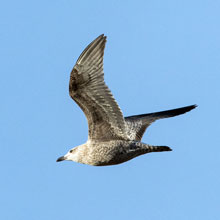 |
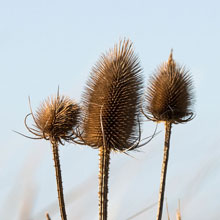 |
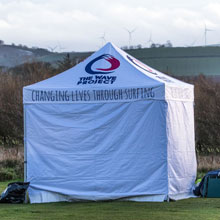 |
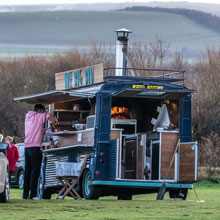 |
We agreed it had been a very pleasant walk in a delightfully beautiful
part of East Lothian. Our sightings had been many and various. My
particular favourite was the “invasion” of the flock of
waders swooping speedily over the blue waters of the Tyne mouth. We
celebrated, of course, by demolishing Cinnamon Danish pastries washed
down with strong tea. We were both weary, but mellow, satisfied with all
aspects of the visit. Hopefully our next visit will be just as good.
Pictures of the Week:
| Goldfinch |
Skylark |
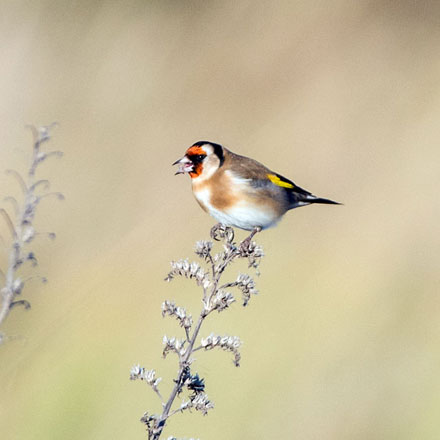 |
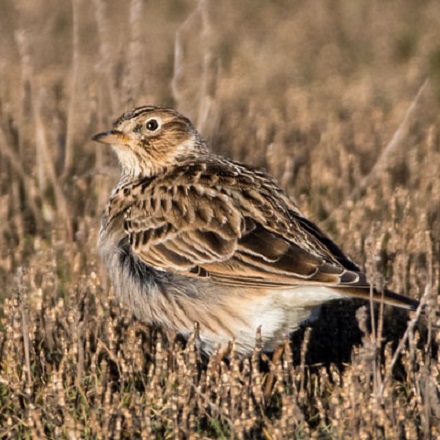 |
| Carrion Crow |
Twite |
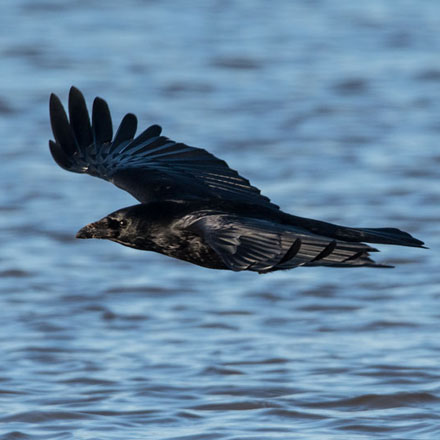 |
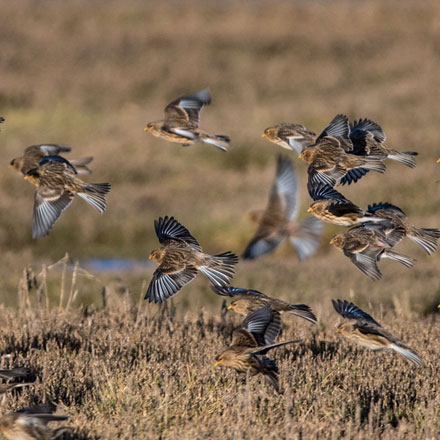 |
9th December 2018: Aberlady and Port Seton
Like last week we had the same weather predicted across the whole of
Scotland’s Central Belt, but this time it was to be bright sunny
weather throughout. I rather fancied going to Aberlady as in recent
weeks there had been reports of interesting sightings, such as the
Shore Lark at Kilspindie. We drove, then, east to the Lothians where,
much to our disappointment, we found the skies were filled with low,
grey clouds. Hoping that it would soon clear, we went into Dalkeith
Morrisons for breakfast (8.5/10, nice food but slow service). When we
emerged the clouds were punctuated by patches of blue so we were fairly
optimistic as we completed our journey to Aberlady.
Kilspindie
We parked on the A198 just before the approach road into Kilspindie
Golf Club. On the shore we immediately found a flock of about 30 Wigeon
nibbling in the salt marsh. They were fairly close to us, but the light
was still pretty dim (see also “Pictures of the Week”,
below). We picked our way west along the marshy shoreline. The tide was
well out and there were a few patches of birds visible but they were
fairly distant. To our great delight the sky cleared pretty quickly to
leave the bright conditions we had expected and we got some passable
pictures of a few Lapwings that were on the exposed sands. John spotted
a solitary Golden Plover near to the Lapwings. We wondered why it had
become detached from its flock. Perhaps it was unwell. As we veered
north towards the area the Shore Larks had been seen, we passed wrecks
of some fishing boats. Apparently there were 8 boats that were sunk
there in the period at the end of the 19th to the start of the 20th
centuries.
We searched the salt marshes just to the north of the Kilspindie Golf
Club car park but sadly the Shore Larks were nowhere to be seen.
Another birder told us they had flown off an hour before we arrived (I
subsequently learned they had returned soon after we left!). We
observed that there were some birds in the channel of the Peffer Burn,
notably more Wigeon, Eider and Mallards. About 500m to the north beyond
the Burn, John pointed out an impressive collection of 250 +/- 50 Shelduck .
Overhead, in the distance I heard the honking of geese flying in from
the Forth. As they came nearer I saw by their orange beaks that they
were Greylags. They flew across our view and towards Aberlady LNR.
| Eider |
Mallard |
Shelduck |
Greylag Goose |
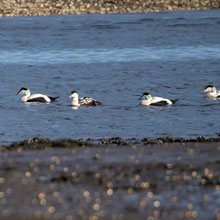 |
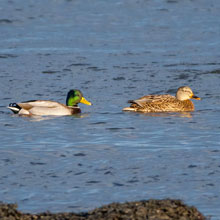 |
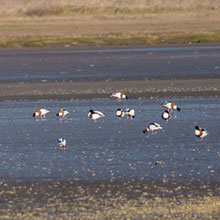 |
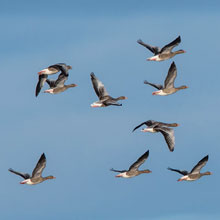 |
To the north-east, the light of the low sun had coloured the very prominent hill called North Berwick Law .
It is the remains of an ancient volcano that was active about 300
million years ago. About a mile away from us we could see the south
shores of the Forth where very large flocks of Oystercatchers were in
the air, with south Fife in the background. As we retraced our
footsteps back to the car, I snapped a few Bar-tailed Godwits flying up
the Peffer Burn. A cautious Curlew left the channel and crept towards us
along a trickle of water. The low sun was behind us so it probably was
unaware of our presence.
| North Berwick Law |
Oystercatcher |
Curlew |
Bar - tailed Godwit |
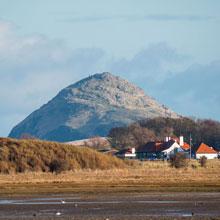 |
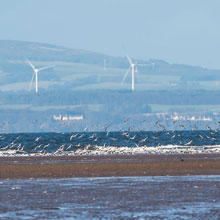 |
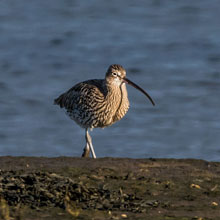 |
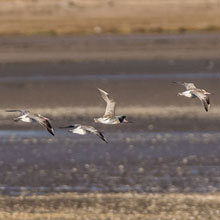 |
Next I captured images of a fly-past of a quartet of Oystercatchers and
of a well-lit Lapwing that was sitting amid a nearby pile of rotting
seaweed. Greylags were still wandering the skies in an excited state,
this time flying even closer. Just as we were about to move off of the
salt marsh, John directed my attention to a single Red-breasted
Merganser sitting mid-channel looking rather lost.
| Oystercatcher |
Lapwing |
Greylag Goose |
Red - breasted Merganser |
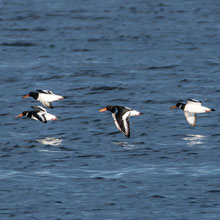 |
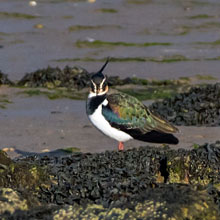 |
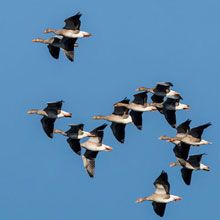 |
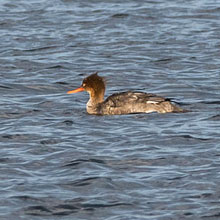 |
I used my iPhone to record an impression of the scene before us as we left Kilspindie.
Aberlady LNR
I next wanted to check out the Marl Loch in Aberlady LNR as it has thrown up some interesting sightings in the past, such as the
Long-eared Owl .
The walk there too can be rewarding, as we found out on crossing the
rickety wooden footbridge. We heard the familiar calls of Fieldfares in
the Sea Buckthorn thickets, then one of them suddenly appeared just in
front of us. It must have been starving as these birds are normally
very flighty, and will fly off at the mere glimpse of a human. It was
feasting on the mass of orange berries. Then to our surprise and
delight, a female Bullfinch joined the feast, although it didn’t
seem to eating berries. After snapping a Magpie that had been sitting
in the conifers beyond the fieldfares, we moved on to the Marl Loch and
sat expectantly on our 3-legged stools waiting for something to
photograph. John spotted the fairly uncommon sight of a Moorhen nibbling at the berries on the branches of the Sea Buckthorn
| Fieldfare |
Female Bullfinch |
Magpie |
Moorhen |
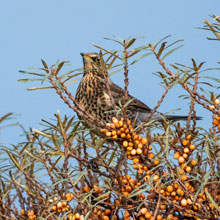 |
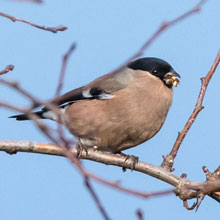 |
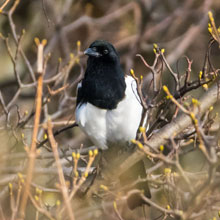 |
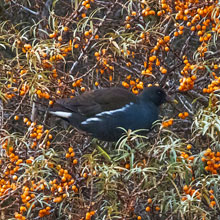 |
.
As the sun started to set and low clouds crept ever-nearer from the
west, the light deteriorated. A raptor sped across our view from right
to left above the Loch - its dark brown vertical stripes on the
underside of its body identified it as a juvenile Peregrine .
Somewhat pleased, we headed back to the car, after quickly taking a
picture of some Sea Buckthorn berries. Back at the wooden bridge, some Teal
were dabbling in the salt marsh. These are smallest of our ducks. The
tide was now coming in and what had been wide expanses of sands had
become a seascape. As we crossed the bridge a pair of Teal passed
overhead down the Peffer Burn.
| Juvenile Peregrine |
Sea Buckthorn |
Teal... |
|
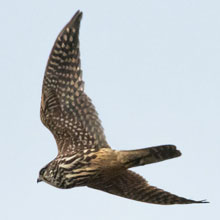 |
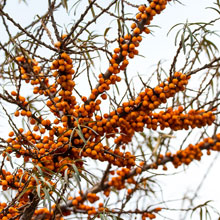 |
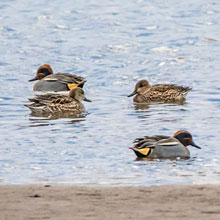 |
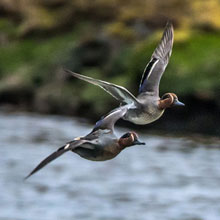 |
Port Seton
At the car in Aberlady we decided we were about done for the day and
we’d move west along the coast to Port Seton where we’d
watch the last of the incoming tide as we sipped our tea inside the
car. However when we got there we discovered that rocks nearest the sea
wall, which were uncovered by the sea, were covered by flocks of small
waders. Most were Dunlin, now in their winter plumage. Also, a few
Redshanks were hanging onto the wet rocks. Right by the sea wall on the
last remaining patch of sand there were several Turnstones scurrying
around, dodging the action of the waves as they tried to feed. Their
dark, mottled, brown plumage contrasted with that of a fourth species
we saw, the Sanderling which has light grey and white winter plumage.
| Dunlin |
Redshank |
Turnstone |
Sanderling |
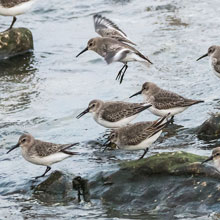 |
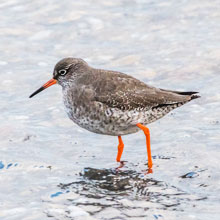 |
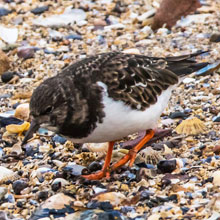 |
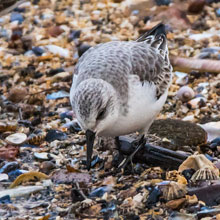 |
The light was now very dusky. A pair of Herring Gulls ghosted past, an adult and a first cycle juvenile. Out in the Firth of Forth we could just make out a navy vessel, HMS Scott,
an ocean survey vessel. An impression of how the light was at this
point can be had from our final image of the bridges over the Forth,
which can just be seen in silhouette, and the flashing warning lights on
their posts can also be seen. The rocks that had provided perching
positions for the waders had become fully submerged. The birds had
flown. It was time for tea.
| Herring Gull |
1St Cycle Herring Gull |
HMS Scott |
Forth Bridges |
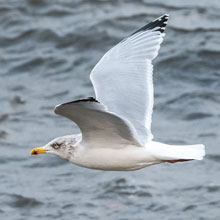 |
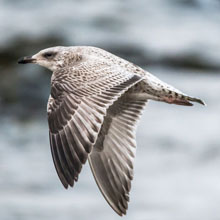 |
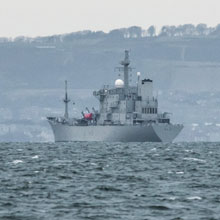 |
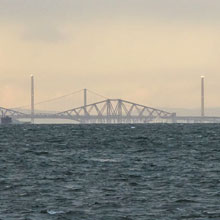 |
Once again we had failed to see our target species, and once again we
had seen a fair old collection of sightings. My favourite was the
Peregrine. Although it was brief and in poor light, it was quite
thrilling to see one of the world’s foremost species (IMHO). To
our regular readers it probably goes without saying that the teas and
pastries were very enjoyable, but this would be an understatement as
the Danish pastries were particularly scrumptious. Roll on next week!
Pictures of the Week:
| Female Wigeon |
Fieldfare |
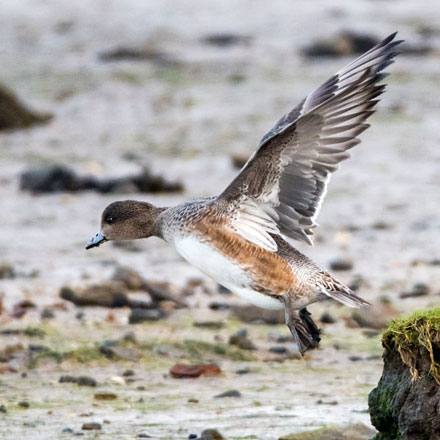 |
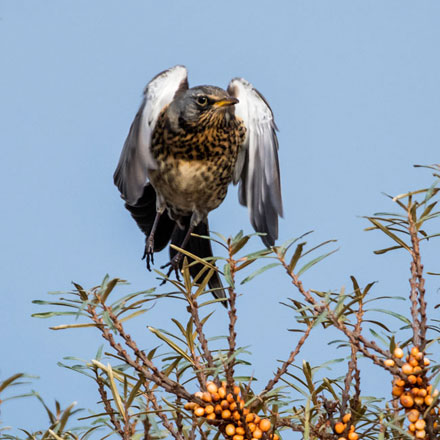 |
| Dunlin |
Sanderling |
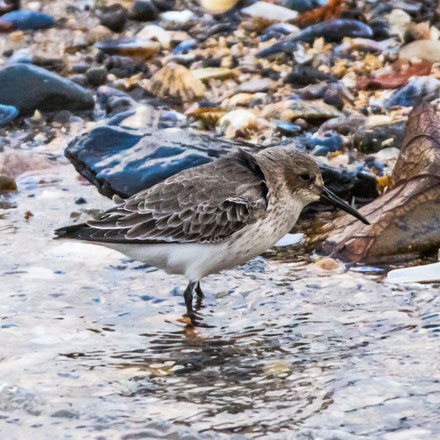 |
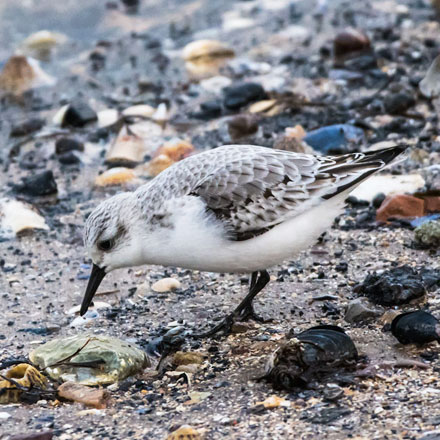 |
2nd December 2018:
Musselburgh
This week we had the whole of Central Scotland to choose from as the
weather was similar throughout - dull, gloomy and damp - hardly
conditions conducive to fine photography, but, we’re experienced
enough at watching nature to know that it can be observed in all
conditions, and interesting pictures are still possible. We headed east
to Musselburgh via Dalkeith where we enjoyed a fine, warm breakfast in
Morrisons cafe (9/10, -1 for leaky teapot and messy table).
In Musselburgh I thought it would be nice to start near the Millhill
car park that overlooks the River Esk at a point where water birds
usually congregate. On arrival it was evident I’d made a good
decision as there were lots of birds on the river. I managed some
satisfying shots of a few Mute Swans that were feeding off the river
bank (see also, “Pictures of the Week”, below). I quickly
moved away from there to capture some shots of a pair of fighting
Mallard drakes. It seemed the drake with the brighter-coloured bill was
getting a pounding from a male with a duller bill. Apparently a Mallard’s bill colour is symptomatic of it’s sexual health. Maybe that had something to do with the argument.
I don’t know if the duck commotion had an unsettling effect on some of the other birds, but there was an outbreak of preening and wing flapping. Female Mallards, Mute Swans, Canada Geese and even Herring Gulls were all in a flap.
| Female Mallard |
Mute Swan |
Canada Goose |
Herring Gull |
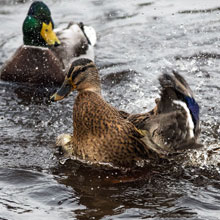 |
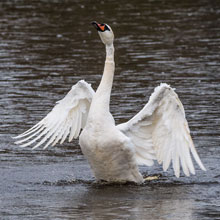 |
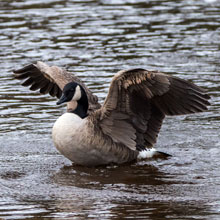 |
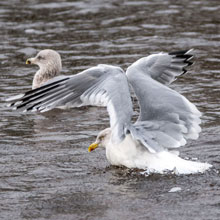 |
We walked up to the footbridge that overlooks an island and the area
where some kind people turn up to feed the birds. I noticed a single Duclair Duck
amongst the feeding melee of Canada Geese, Mallards and of course,
Black-headed Gulls. Below the footbridge, on the edge of the island, I
spotted a pair of geese, a Greylag with a Greylag/Canada hybrid .
| Duclair Duck |
Canada Goose |
Greylag / Canada Hybrid |
Greylag Goose |
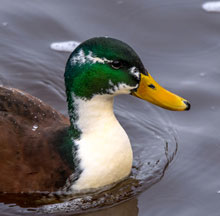 |
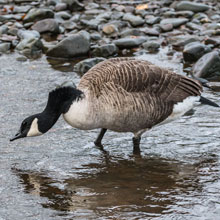 |
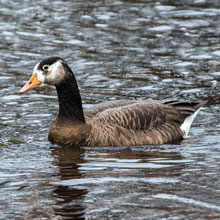 |
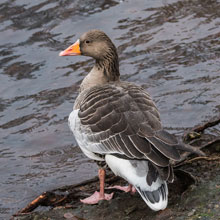 |
On the walkway that runs along the river, some feral pigeons were
picking up the leftovers after the feeders had gone. One pigeon
caught my eye due to its unusual plumage. I have called it a
“Pied Feral Pigeon”, which, like most wild pigeons, is
descended from Rock Doves . Also nibbling at the crumbs were Jackdaws ,
the smallest members of the Crow family, and Black-headed Gulls (see
also, “Pictures of the Week”, below). John pointed out a
pair of female Goosanders floating mid-channel further upstream. They
were inactive. Maybe they were resting after a hard morning’s
diving for fish.
| Feral Pigeon |
Jackdaw |
Black - headed Gull |
Goosander |
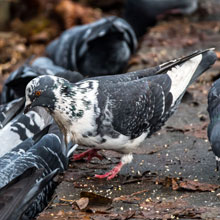 |
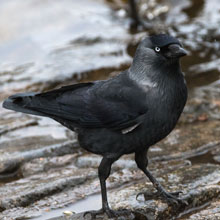 |
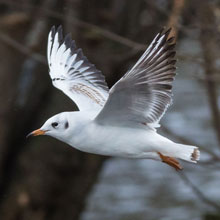 |
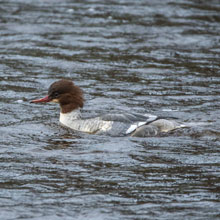 |
Having had our fill of observations at Millhall we moved down to the end
of Goose Green Place, just before the Cadet Hall, where we immediately
saw a Goldeneye midstream at the mouth of the Esk. We put up a large
flock of Redshanks that had been sheltering out of sight on the near
bank. The tide was high, so the birds were fairly inactive waiting for
the feeding opportunities that would come as the waters receded. That
must have been about to happen as waves of Oystercatchers were flying
into the area from their high-tide roosts, such as the Scrapes. We came
across the Redshanks flock on the rocky shore further downstream (see
also, “Pictures of the Week”, below). Mingling with them
were a few Turnstones.
| Goldeneye |
Redshank |
Oystercatcher |
Turnstone |
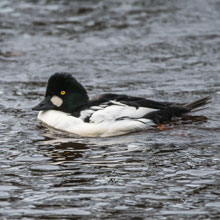 |
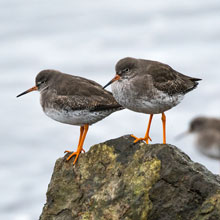 |
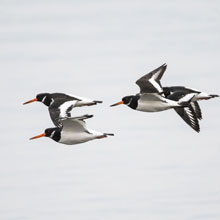 |
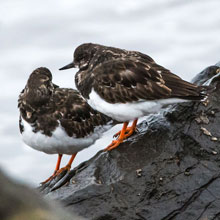 |
The weather had been dull but dry, but as we left the Esk mouth the
light got really dull and it began to rain. The view across to
Portobello will give you an impression of the conditions - as we say in
Scotland, it was “dreich”.
We scanned the seascape as we headed to the Scrapes at Levenhall Links.
Some Velvet Scoters were about 70m out. We couldn’t make out much
detail with the naked eye, but my camera did not too bad. They seemed
to be courting rather than diving. Further east, another diving
species, a pair of female Red-breasted Mergansers ,
were passing. They didn’t dive but seemed to be moving closer.
Not far behind were a pair of Shags, more divers, that also edged
towards us and actually got close enough for as good a picture as we
were going to get in the conditions. The fourth diving bird we saw on
our walk to the Scrapes was a winter plumage Great Crested Grebe . It too was close to the sea wall. It dived a few times before it presumably saw us and moved off.
| Velvet Scoter |
Red - breasted Merganser |
Shag |
Great Crested Grebe |
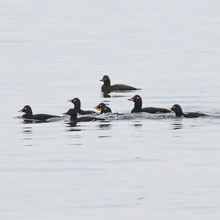 |
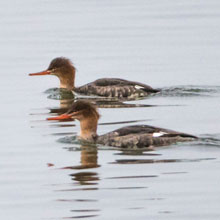 |
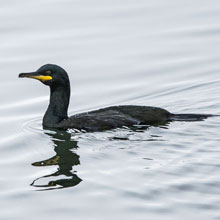 |
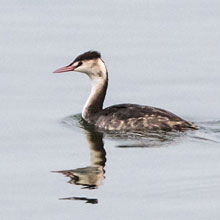 |
As I photographed the divers in the rain and gloom I was joined by an
insect that looked like a Mosquito or Gnat. It seemed very late in the
year to be seeing it, a sign of the mild weather we’ve had. A
familiar “cheep” heralded the arrival of a Pied Wagtail,
that, given the choice, would surely have gobbled up the Gnat.
Simultaneously, a female Reed Bunting (linkI) flew onto the wall. It was
no more than 5m away but we could hardly make out its plumage due to
the terrible light. Honking Greylags flew overhead and into the Scrapes,
leading us to move away from the sea wall to observe them and the birds
they had joined.
| Gnat |
Pied Wagtail |
Female Reed Bunting |
Greylag Geese |
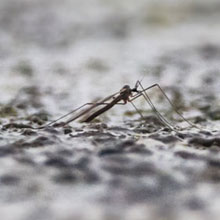 |
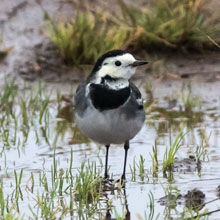 |
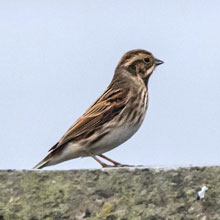 |
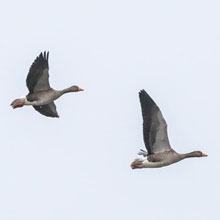 |
As we entered the Scrapes
we weren’t too hopeful of seeing much but we pressed on. From the
east-most hide we found about a dozen Wigeon feeding in the grass in
front of the hide (see also, “Pictures of the Week”,
below). In the west-most hide we found ten Lapwings resting in the middle of the scrape. Closer to the hide a half dozen
Dunlin and a few Teal were feeding. I felt as if I was taking pictures
in the dark, so we called it a day and made our way back to the car. En
route John was sure he saw a Short-eared Owl around the area I call
“the bing”. As we investigated, we met a couple who also
had seen it. Unfortunately it failed to reappear so I didn’t get
a picture. However, the banner at the top of this page shows a photo of the Short-eared Owl we saw in the same area almost exactly three years ago.
| Wigeon |
Lapwing |
Dunlin |
Teal |
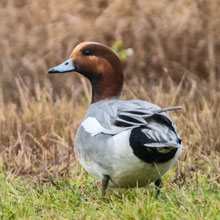 |
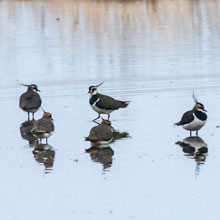 |
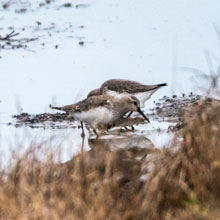 |
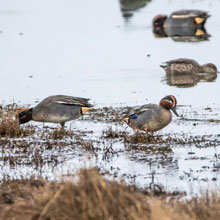 |
Instead of our more usual al fresco cuppas, we had our tea and very
nice Danish pastries inside the car. We’d had quite enough of the
cold damp weather. We were satisfied with the sightings (some of which
we struggled to see!) and the pictures were satisfactory and fairly
interesting. We hope next week’s weather is much better, but if
it’s not, we’ll once again do our best to get some more
interesting pictures.
Pictures of the Week:
| Mute Swan |
Black - headed Gull |
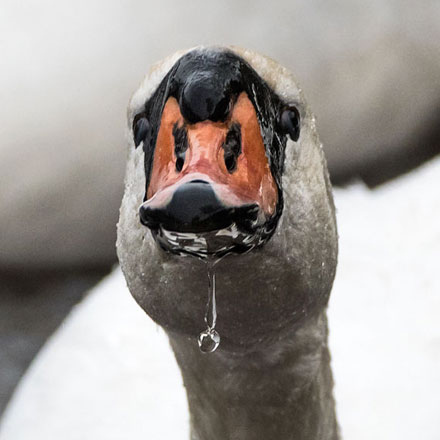 |
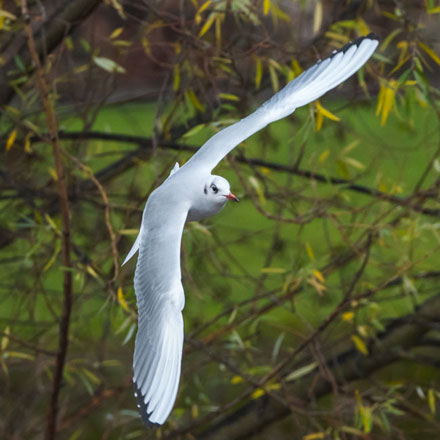 |
| Redshank |
Wigeon |
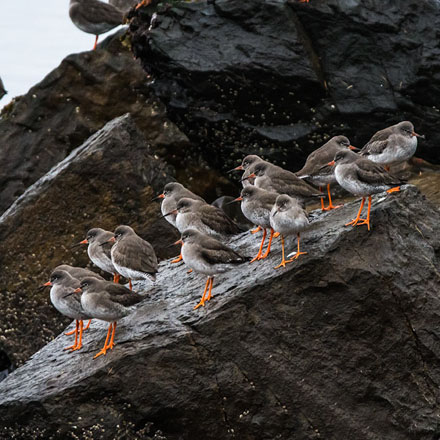 |
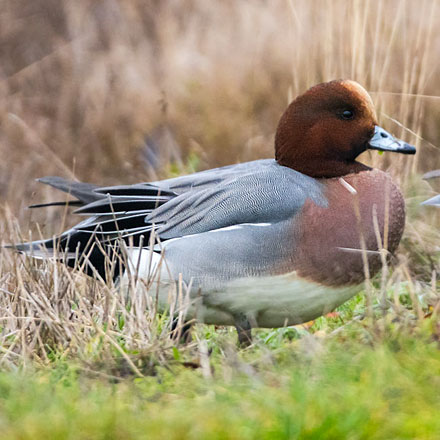 |
Back To Top
|
|

